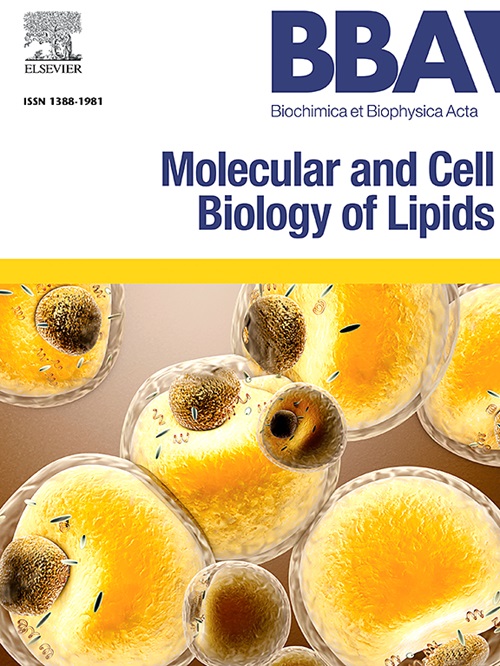高甘油三酯血症损害HDL功能,促进巨噬细胞代谢激活,加剧抗原诱导的类风湿性关节炎,非诺贝特治疗可逆转。
IF 3.3
2区 生物学
Q2 BIOCHEMISTRY & MOLECULAR BIOLOGY
Biochimica et biophysica acta. Molecular and cell biology of lipids
Pub Date : 2025-09-08
DOI:10.1016/j.bbalip.2025.159686
引用次数: 0
摘要
类风湿性关节炎(RA)与心血管疾病(CVD)风险增加相关,部分归因于脂质代谢改变。载脂蛋白C-III (apoC-III)是血浆中富含甘油三酯的脂蛋白的关键调节因子,与血脂异常和炎症有关。在这项研究中,我们使用过表达人类apoC-III基因(apoC-III Tg)的转基因小鼠模型研究了高甘油三酯血症在RA中的作用。使用抗原诱导关节炎(AIA)的方案,我们发现与非转基因对照相比,apoC-III Tg小鼠表现出明显更大的关节肿胀,炎症浸润和软骨破坏。这些变化伴随着血清中脂蛋白分布的改变和HDL功能障碍,包括抗氧化功能降低。此外,从关节炎apoC-III Tg小鼠中分离的HDL对巨噬细胞具有促炎特性,其表现为iNOS和il - 1β表达增加以及线粒体呼吸增加。非诺贝特(一种降低甘油三酯的药物)治疗关节炎apoC-III Tg小鼠,降低甘油三酯水平,增加HDL分数中的apoA-I含量。重要的是,非诺贝特显著改善关节炎严重程度,恢复HDL抗氧化功能,降低巨噬细胞活化。这些发现强调了类风湿性关节炎中血脂异常、高密度脂蛋白功能障碍和炎症加重之间的机制联系,并提示针对apoc - iii相关途径可能为共存代谢和炎症性疾病的患者提供治疗益处。本文章由计算机程序翻译,如有差异,请以英文原文为准。

Hypertriglyceridemia impairs HDL functionality, promotes macrophage metabolic activation and exacerbates antigen-induced rheumatoid arthritis in mice which can be reversed by fenofibrate treatment
Rheumatoid arthritis (RA) is associated with increased cardiovascular disease (CVD) risk, partly attributed to altered lipid metabolism. Apolipoprotein C-III (ApoC-III), a key regulator of triglyceride-rich lipoproteins in the plasma, has been implicated in both dyslipidemia and inflammation. In this study, we investigated the role of hypertriglyceridemia in RA using a transgenic mouse model overexpressing the human ApoC-III gene (ApoC-III Tg). Using a protocol of antigen-induced arthritis (AIA), we show that ApoC-III Tg mice exhibited significantly greater joint swelling, inflammatory infiltration and cartilage destruction compared to non-transgenic controls. These changes were accompanied by altered lipoprotein distribution in serum and High Density Lipoprotein (HDL) dysfunction including reduced antioxidant function. Furthermore, HDL isolated from arthritic ApoC-III Tg mice had pro-inflammatory properties on macrophages as demonstrated by the increased expression of iNOS and IL1β as well as increased mitochondrial respiration. Treatment of arthritic ApoC-III Tg mice with fenofibrate, a triglyceride-lowering drug, reduced triglyceride levels and increased ApoA-I content in HDL fractions. Importantly, fenofibrate significantly ameliorated arthritis severity, restored HDL antioxidant function and reduced macrophage activation. These findings highlight a mechanistic link between dyslipidemia, HDL dysfunction, and inflammatory exacerbation in RA and suggest that targeting ApoC-III-associated pathways may offer therapeutic benefit in patients with coexisting metabolic and inflammatory disorders.
求助全文
通过发布文献求助,成功后即可免费获取论文全文。
去求助
来源期刊
CiteScore
11.00
自引率
2.10%
发文量
109
审稿时长
53 days
期刊介绍:
BBA Molecular and Cell Biology of Lipids publishes papers on original research dealing with novel aspects of molecular genetics related to the lipidome, the biosynthesis of lipids, the role of lipids in cells and whole organisms, the regulation of lipid metabolism and function, and lipidomics in all organisms. Manuscripts should significantly advance the understanding of the molecular mechanisms underlying biological processes in which lipids are involved. Papers detailing novel methodology must report significant biochemical, molecular, or functional insight in the area of lipids.

 求助内容:
求助内容: 应助结果提醒方式:
应助结果提醒方式:


